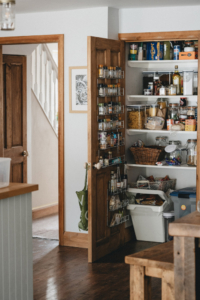10 Tips for Food Storage: How To Keep Food Fresh & Safe
Proper food storage is important for maintaining safe food, nutritional value, and freshness. These tips will help you organize and store your food effectively, reducing waste and promoting a healthier lifestyle.
- Understand Storage Zones:
- Different foods require different storage conditions. Divide your kitchen into zones based on temperature and humidity needs. For instance, store fruits and vegetables in the crisper drawer of your refrigerator, while pantry items like grains and canned goods should be kept in a cool, dry place.

- Different foods require different storage conditions. Divide your kitchen into zones based on temperature and humidity needs. For instance, store fruits and vegetables in the crisper drawer of your refrigerator, while pantry items like grains and canned goods should be kept in a cool, dry place.
- Utilize Airtight Containers:
- Invest in high-quality airtight containers for storing dry goods like rice, pasta, and cereal. These containers prevent exposure to air and moisture, keeping your pantry staples fresh for longer periods and reducing the risk of spoiling or even pests.
- Label and Date:
- Labeling containers with the purchase or expiration date helps you keep track of the freshness of your food. This is particularly important for items in the freezer, as it helps you rotate stock and use older items first.
- Practice FIFO (First In, First Out):
- When restocking your pantry or refrigerator, place newer items behind older ones. This simple practice ensures that you use the older items first, preventing food from expiring or going bad before you get a chance to use it.
- Freeze Smartly:
- Freeze items in portion sizes to make thawing and using them more convenient. Use freezer bags or vacuum-sealed bags to minimize freezer burn, and be sure to remove excess air before sealing. Label frozen items with the date and type for easy identification.
- Store Meat Safely:
- Raw meat and poultry should always be stored on the lowest shelf of the refrigerator to prevent cross-contamination. Keep them in leak-proof containers or on a tray to catch any potential drips.
- Monitor Refrigerator Temperature:
- Keep your refrigerator at or below 40°F (4°C) to slow down the growth of bacteria. Use a refrigerator thermometer to ensure the proper temperature and adjust settings accordingly.
- Rotate Your Stock:
- Regularly assess the contents of your pantry, refrigerator, and freezer. Use items nearing expiration first
 and replace them with fresh purchases. This practice not only reduces food waste but also ensures that you’re consuming the most nutritious products.
and replace them with fresh purchases. This practice not only reduces food waste but also ensures that you’re consuming the most nutritious products.
- Regularly assess the contents of your pantry, refrigerator, and freezer. Use items nearing expiration first
- Avoid Overpacking:
- Overpacking your refrigerator can obstruct proper airflow, leading to uneven cooling and potential food spoilage. Allow air to circulate by leaving some space between items, and don’t block vents. Also, as you learn your appliances, you may have experienced your fresh produce freezing at the back of the fridge. Proper placement can save you food and money.
- Educate Yourself on Shelf Lives:
-
- Understand the shelf life of various foods to make informed decisions about what to purchase and when to use it. Familiarize yourself with expiration dates, and be aware of signs of spoilage such as off odors, discoloration, or changes in texture.

Conclusion:
By following these tips, you can create a well-organized and efficient food storage system in your kitchen. Not only will you reduce food waste, but you’ll also ensure that your meals are made with fresh, safe ingredients. Embracing these practices will not only benefit your wallet but also contribute to a healthier and more sustainable lifestyle. Happy storing!


